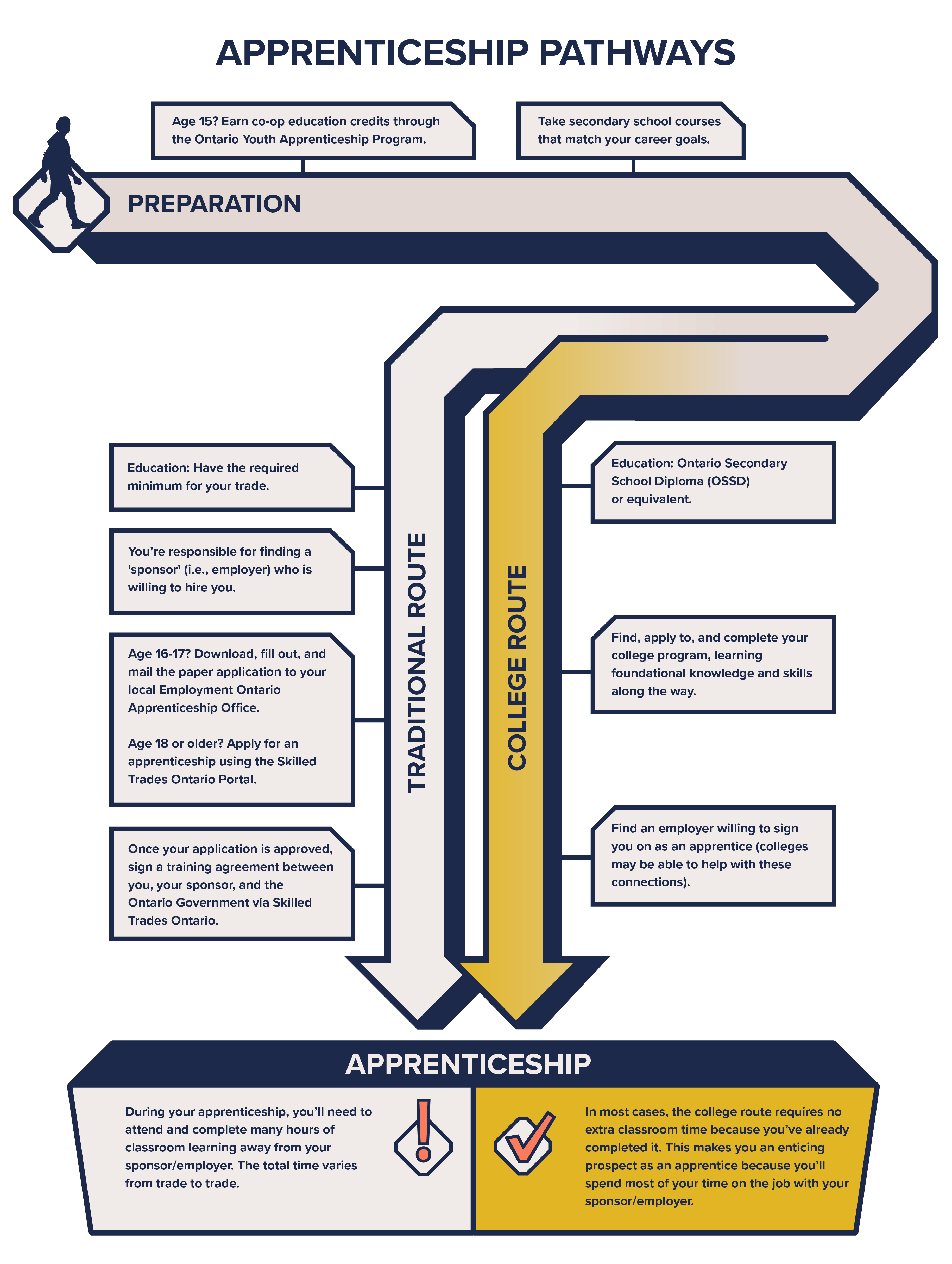Apprenticeships
College vs. Traditional Apprenticeship Pathways
There are a couple of options for pursuing an apprenticeship in Ontario.
You could use our program search tool to find a program at a college. There, you can develop the skills that will prepare you for an apprenticeship and skilled trades career.
Or you could focus on getting an apprenticeship without prior training.
What’s the best approach for you?
It’s a complicated question and the answer depends a lot on your unique personal and professional situation.


Apprenticeship Pathways
Preparation
- Age 15? Earn co-op education credits through the Ontario Youth Apprenticeship Program.
- Take secondary school courses that match your career goals.
Traditional Route
- Education: Have the required minimum for your trade.
- You're responsible for finding a 'sponsor' (i.e., employer) who is willing to hire you.
- Age 16-17? Download, fill out, and mail the paper application to your local Employment Ontario Apprenticeship Office.
- Age 18 or older? Apply for an apprenticeship using the Skilled Trades Ontario Portal.
- Once your application is approved, sign a training agreement between you, your sponsor, and the Ontario Government via Skilled Trades Ontario.
College Route
- Education: Ontario Secondary School Diploma (OSSD) or equivalent.
- Find, apply to, and complete your college program, learning foundational knowledge and skills along the way.
- Find an employer willing to sign you on as an apprentice (colleges may be able to help with these connections).
Apprenticeship
- Traditional Route
- During your apprenticeship, you'll need to attend and complete many hours of classroom learning away from your sponsor/employer. The total time varies from trade to trade.
- During your apprenticeship, you'll need to attend and complete many hours of classroom learning away from your sponsor/employer. The total time varies from trade to trade.
- College Route
- In most cases, the college route requires no extra classroom time because you've already completed it. This makes you an enticing prospect as an apprentice because you'll spend most of your time on the job with your sponsor/employer.
Advantages of a College Program in the Skilled Trades
As we’ve explored on other parts of this site – like our Why College? section – the advantages of going to college include:
- You can take trades programs that let you skip the in-class training portion of a future apprenticeship, saving you time and making you more appealing to employers.
- You will always have the diploma, degree, or certificate that you get with a college program, opening doors for your career in the future.
- You may be able to access co-op opportunities through employers in your college’s area.
Beyond that, college trades facilities and experienced professors can help you get a feel for your future career and work environment. If one trade is not for you, then you can leverage your college support system to find another that’s a better fit.
But let’s go further in comparing college and traditional apprenticeship pathways to a skilled trades career. Both routes have their benefits and understanding their differences can help you make an informed decision.
College Pathways
Advantages
Considerations
Traditional Apprenticeship Pathways
Advantages
Considerations
Conclusion
Both pathways have their benefits, and the best choice for you depends on your individual preferences and circumstances. Aspiring tradespeople should explore their options, consider their learning style, and weigh the benefits of each route. Whether through college or traditional apprenticeships, a skilled trades career in Canada awaits those willing to put in the effort and dedication.
